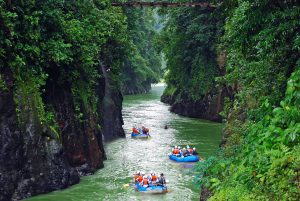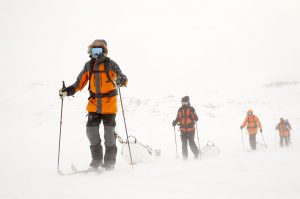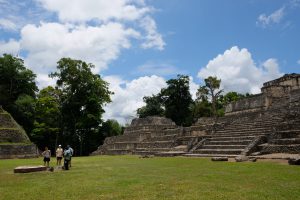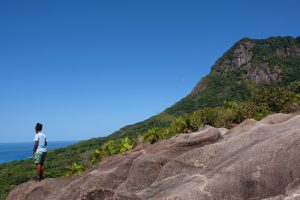
The black-tipped Cuernos del Paine, Torres del Paine National Park. Image: Amelia Duggan
Lace up your walking boots and pack light. Down in the far-flung latitudes of the Chilean Patagonia, Torres del Paine National Park’s ‘W’ trail offers hikers a challenging five-day, 45-mile circuit through crescendoing peaks and hanging glaciers
“Pick whichever you want, they’re all wild,” Camilo shouts into the wind, securing his beret with one hand and motioning to a lineup of stout, tethered ponies with the other. He and the other stable hands are in the process of coaxing a bucking stallion into a bridle. It’s a fantastic scene — one that, appropriately for our remote setting, seems to speak of the temerity of men in the face of unpredictable, unyielding nature.
Soon, Camilo is saddled up and all is clearly forgiven between him and the truculent horse: “I often feel like that in the morning,” he concedes, patting its mane as he leads our caravan of riders and packhorses away from the Las Torres stables. Our horse wrangler is a baqueano — a Patagonian cowboy — and is a commanding presence on horseback. He’s sporting a felt boina hat, high boots and a knife, sheathed in leather and tucked through his waistband. The earth tones of his woolen garbs chime with the landscape; he’s poetry in motion. My Chilean friend, Felipe, and I, on the other hand, cut less elegant figures in conical riding helmets and neon hiking jackets. Still, as white fog cascades off the foothills and drifts low across the yellow pampas, obscuring our route, I’m grateful for this gentle, trotting introduction to the circuit.
However, the path turns challenging, and my poor pony ploughs through icy torrents, hooves scrabbling for purchase on steep, pitted paths. And as we climb higher and higher, my Spanish vocabulary expands in unpleasant ways. Barranco, I learn after Camilo shouts it back at us through the mist, translates as ‘precipice’. And rachas? ‘Gusts’ — the wind, he says, can barrel through at 100mph.
In Patagonia, you can experience the four seasons in one day, Felipe had warned me on the journey here. We’d linked up in Santiago and flown south — three turbulent hours tracing the backbone of the Andes — to Punta Arenas, then caught a bus to the park’s nearest town, Puerto Natales. A map hung in my hotel hinted at the fun early settlers had battling the elements around here. Port Famine. Useless Bay. Deception Island. Last Hope Sound. There’s a word — indomita — reserved in the Chilean lexicon for the country’s deep south: untamed, unconquerable.
But if Patagonia is indomita, so are its residents. A Natales local told me the snowy winters are characterised by heavy carousing and fine dining (“restaurants are our pet projects”), while summer’s fixtures include raucous lamb barbecues, death-defying car rallies and jineteada rodeos. There’s no road linking lower Patagonia with the rest of Chile, and so the customs and dialect here are pretty unique, forged from a spirit of rugged individualism. “Most Chileans think there are Magellanic penguins living in our main square! What do Santiaguinos 1,800 miles away know of life here?” I’m told.
That sense of remoteness hits home when Camilo, Felipe and I finally dismount at a wooden chalet poking out of dense forest. A low ceiling of fog continues to hang menacingly over us. And it’s cold, so very cold. This is as far as the animals can go; we must continue to the viewpoint on foot, and return to this refugio to bunk tonight. So we bid Camilo and the horses a grateful goodbye as they head back to the stables, and then peek indoors: there are dorms with heavy, brightly coloured duvets; racks in front of wood-burners to dry off muddy boots; long pine trestle tables, ideal for sharing trail stories over bottles of Chilean Carménère; and a blackboard menu promising a hot dinner. I’m loath to leave, but getting up to the viewpoint is non-negotiable: tackling the trail from east to west means greeting the Torres del Paine mountains at the start.
The hike is magnificent, passing through fairytale woodlands decorated with wispy, mint lichen and electric baubles of yellow fungus, up to a stark valley of boulders and deep pockets of snow. It’s steep, sweaty, climbing-with-your-hands, feeling-the-cartilage-in-your-knees stuff, so I’m stripping off layers despite the chill. The wind is wailing in my ears when we crest the hill and discover a milky-emerald lagoon and perhaps the most sublime mountain vista I’ve ever seen. It’s the first of many gifts from the park: for those first minutes, Felipe and I are slumped at the viewpoint, muscles burning and lungs heaving, the clouds unfurl to reveal three cragged granite towers — the Torres — ascending from a great, iridescent glacier of white and crystal-blue ice. To think, this is only day one.

Camilo putting a bridle on his horse. Image: Amelia Duggan
The French Valley
While the ‘W’ could easily stand for ‘wind’ or ‘wild’ (or, during more gruelling sections, ‘why!’), the trail’s name is taken from its shape, tucking in and around the southern base of the Cordillera del Paine. The peaks quickly become familiar friends, the only constants in a landscape shaped by microclimates. Besides the Torres, there’s the towering hulk of Paine Grande, and the Cuernos — twin, black-tipped, horn-like protrusions — which loom over us on day two as we trace the banks of Nordenskjöld Lake, stopping regularly to skip pebbles on its mirror surface in the glorious sunshine.
The range is only 13 million years old — a relative young’un, a passing ranger tells me when we get chatting, citing the jagged ridges as evidence. Their rough edges are only just starting to be smoothed.
The same could be said of the trail. While the campsites and refugios in the park are being developed and expanded, and visitor numbers are rising each year, the ‘W’ still feels like a leap into the wildest wilds. We encounter only a handful of other hikers each day, drink straight from the streams, spot condors circling over pumas’ discarded carrion, wade through rivers, and see a rare double halo around the moon. The glacial lagoons shimmer different blues, scored by the white crests of wind-raked waves. And even when passing through the valleys decimated by wildfire in 2011, the bare tree trunks suggest a forest of antlers twisted by the wind and polished to a bright silver.
Just after sunrise on the third day, Felipe and I gather together with a motley band of internationals we’d met the previous evening during an informal fireside yoga class and head out en masse. The Cuernos are glowing rose pink above us. My nose is glowing too, smarting in the near-freezing morning chill. It’s set to be the most challenging day yet: weather permitting, we’ll hike all the way through the French Valley up to the centre of the Cordillera — to the middle of the ‘W’ circuit. Driving snow had forced rangers to close the final section of the route yesterday, but the skies are promisingly clear as we start to climb. A stupendous glacier is stacked upon the far mountain; we watch fine clouds billow around and snag on the peaks. We hike through dappled shade to a soundtrack of wind in leaves, running river water and, every now and then, the percussive boom of an avalanche. Each time, we stop and watch the clouds of powdery snow mushroom and then fall in slow motion.
The ascent defeats some of our group, who turn back and hobble towards the next refugio. But, somehow, my legs are holding out. So some six hours after setting off, having followed orange trail markers across miles of woodland like a fabulous treasure hunt, we haul ourselves up a rocky slope and look around. This is Britannico lookout — named for the British mountaineers who used the area as a base camp in the mid-20th century. It’s arguably the finest view in the park. We’re in the centre of an immense basin. In every direction, feathery, purplish woods fan out to meet snowy plateaux topped by sheer towers of grey granite and hulking blackish mountains. The vastness of the scene quietens the group. A hip flask of single malt is passed around. I find myself, not for the first time this week, contemplating the sublimity of the universe.
On the hike down, we’re almost too tired to speak. We cross meadows of herbs and budding flowers, spot a huemul stalking along a cliff edge, and watch the moonrise. Finally, on the shores of Lake Pehoé, circling nesting geese and multi-coloured bell tents, we push through the blizzard-scratched doors of the refugio, and are welcomed by our friends like heroes returning from war.

Hiking towards Grey Glacier. Image: Alamy
The Grey Glacier
Getting out of bed on my fifth and final day in the park is proving a physical challenge; my leg muscles have seized up. I hadn’t stretched the night before, choosing instead to order calafate sours until the refugio’s barkeeper gently suggested Felipe and I turn in. We were celebrating reaching the Grey Lagoon, the westernmost tip of the ‘W’ trek and, in our eyes, the finish line. The cocktail also checked a cultural box: there’s a legend attached to the calafate berry, stemming from the folklore of the region’s now-extinct indigenous tribes — “El que come calafate ha de volver” (“Those who taste it are guaranteed to return”). I feel there’s so much more of Torres del Paine to explore, that I’m more than open to the fates bringing me back.
Our last stop before heading back is the Grey Glacier. We’d seen it from a distance — a giant wall of ice rising from the lake and stretching back through a valley to the horizon — but this is our chance to get up close. We wrap up and take the path down to the waterfront where Arek, one of the intrepid guides at Bigfoot Patagonia, helps us into thick, rubbery dry suits and then into kayaks. Within minutes of paddling, my triceps are screaming, but it’s worth it to skirt through the grey water, dodging small, freshly calved icebergs. “Where they’re pure and blue, that’s when the ice is ancient,” Arek shares, joking that when you spend your summers down here by the glacier you get fussy about the calibre of ice cubes used in your evening whisky.
We dock the kayaks on a rocky outcrop, which Arek affectionately refers to as his office. The view is quite something: not far away, the craggy wall of the Grey Glacier rises some 98ft from the dark water. “It’s always moving, pushing forward,” Arek says. He’s equally restless. In his downtime, Arek undertakes expeditions: crossing the Southern Patagonian Icefield, for example, or kayaking the entire Strait of Magellan. He’s also summited Aconcagua with a blind friend. “It’s when people tell me something’s impossible, that’s when I want to do it the most. Impossible? It’s not impossible.” Years spent in Patagonia have worked their magic on his spirit — a long draught of indomita. I’d like a bit more of that, if it’s going round. But I suppose there’s no rush — I’m destined to come back, after all.
Essentials:
Getting there: British Airways flies directly to Santiago from Heathrow, while other airlines fly indirect from other UK airports. LATAM and Sky operate domestic flights to Punta Arenas, and bus companies including Buses Fernandezbusesfernandez.com operate between Punta Arenas and Puerto Natales. Direct flights between Santiago and Puerto Natales operate December to February.
Average flight time: 14hr30min + 3hr
When to go: The high-summer months between December and February see long daylight hours and average temperatures of 11C, but also see heavy footfall and strong winds. The shoulder months of September, October, March and April are excellent times to visit the park, while the winter months offer beautiful snowy vistas.
More info: chile.travel/en parquetorresdelpaine.cl/en
Published in the Adventure Travel guide, free with with the Jan/Feb 2018 issue of National Geographic Traveller (UK)











